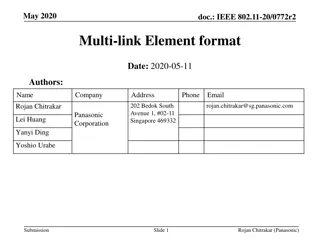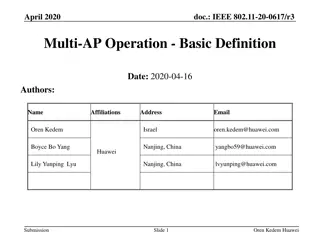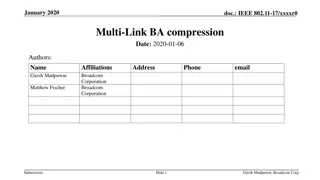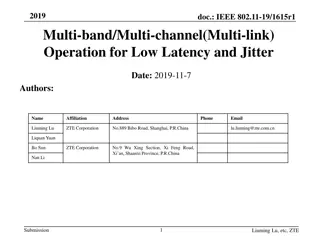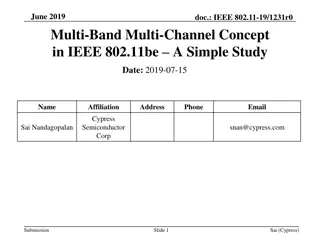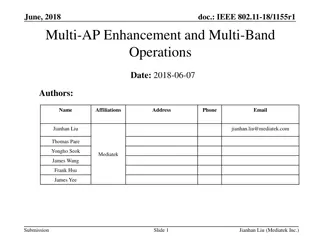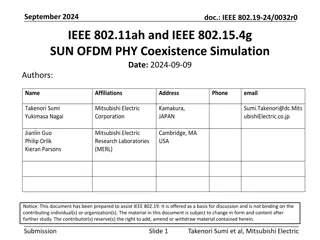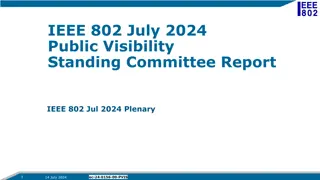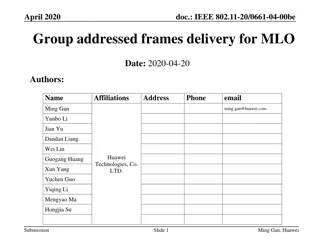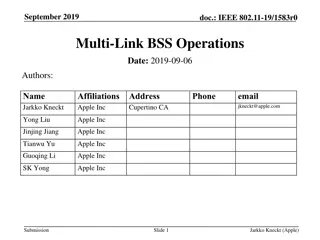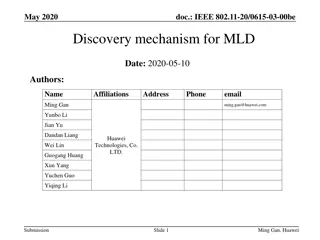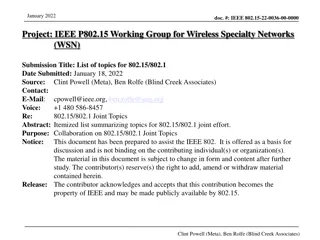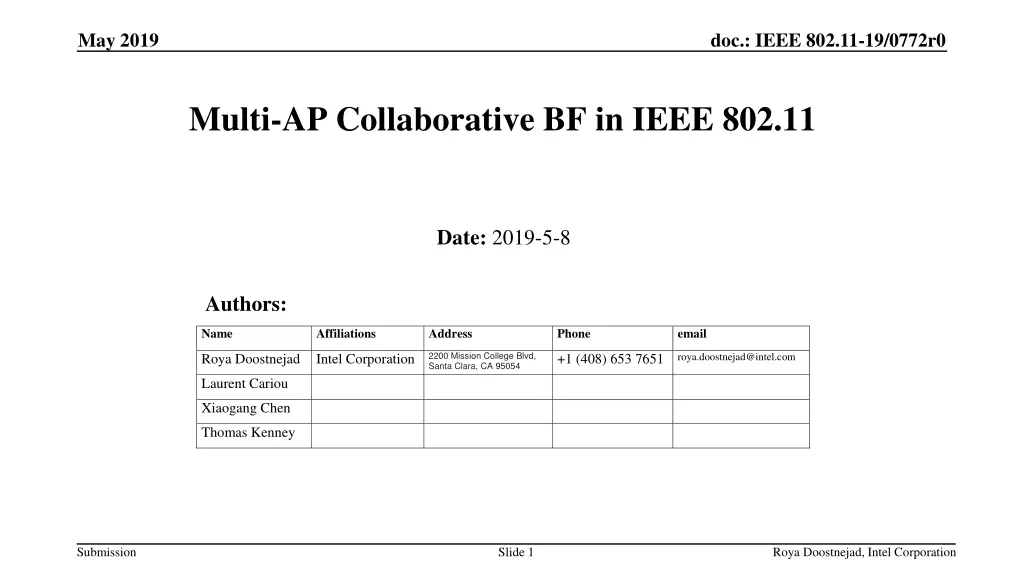
IEEE 802.11 Multi-AP Collaborative Beamforming
Explore the concept of Collaborative Beamforming (CBF) in IEEE 802.11, enabling multiple Access Points (APs) to transmit simultaneously with interference cancellation techniques. This approach enhances spatial reuse, increases area throughput, and allows seamless connectivity for multiple devices. The article discusses key aspects such as transmitter strategies, receiver mechanisms, multi-AP channel sounding, and simulation results.
Download Presentation

Please find below an Image/Link to download the presentation.
The content on the website is provided AS IS for your information and personal use only. It may not be sold, licensed, or shared on other websites without obtaining consent from the author. If you encounter any issues during the download, it is possible that the publisher has removed the file from their server.
You are allowed to download the files provided on this website for personal or commercial use, subject to the condition that they are used lawfully. All files are the property of their respective owners.
The content on the website is provided AS IS for your information and personal use only. It may not be sold, licensed, or shared on other websites without obtaining consent from the author.
E N D
Presentation Transcript
May 2019 doc.: IEEE 802.11-19/0772r0 Multi-AP Collaborative BF in IEEE 802.11 Date: 2019-5-8 Authors: Name Affiliations Address Phone email 2200 Mission College Blvd, Santa Clara, CA 95054 roya.doostnejad@intel.com Roya Doostnejad Intel Corporation +1 (408) 653 7651 Laurent Cariou Xiaogang Chen Thomas Kenney Submission Slide 1 Roya Doostnejad, Intel Corporation
May 2019 doc.: IEEE 802.11-19/0772r0 Introduction Collaborative BF (CBF): Multiple APs transmit in the same time/frequency (each to their own STAs) o Data of Each STA is sent from a Single AP o No joint Data Processing across APs Multi-AP Coordination o Timing/Synchronization across APs o Interference awareness/ Interference Cancellation Spatial Reuse Enhancement through Multi-AP Coordination and interference cancellation Enabling simultaneous connectivity for several devices where interference is a concern Increasing Area Throughput The concept was also introduced in [1] and [2]. Submission Roya Doostnejad, Intel Corporation Slide 2
May 2019 doc.: IEEE 802.11-19/0772r0 Collaborative BF Key: Coordination and Interference Cancellation Transmitter: Transmit Nulling/ ZF and Scheduling at each AP Multi-AP Channel Sounding to provide some information on interference channel Number of transmit antennas at each AP>=number of interfering STAs Ideal interference nulling may not be enforced. o Non-ideal Channel Information o Multiuser/Multi-Cell Residual interference at STA ??? ??? Interference channel ????1 ????2 ????2 ????1 Receiver: MMSE Resolvable LTFs across coordinated multi-AP to enable interference suppression at the receiver Spatial multiplexing (Matrix-P) may be applied across multiple APs to orthogonalize LTFs (improve channel estimation in presence of interference) Training signals for channel estimation at STA are beam-formed Submission Roya Doostnejad, Intel Corporation Slide 3
May 2019 doc.: IEEE 802.11-19/0772r0 Collaborative BF Multi-AP Channel Sounding: Each AP may require channel information for the STAs in OBSS for the sake of interference cancellation. Explicit Feedback o Extending 802.11ax sounding sequence o NDP transmission from APs in downlink o The STAs may be directed to send feedback reports on channel of each individual AP Implicit Feedback o A proposal for single AP/802.11be is presented in [3]. o Training fields are transmitted in the uplink from the required STAs o All APs in coordinated set will be able to measure the channel for all STAs in OBSS o Reduce network overhead significantly Multi-AP Trigger frameis transmitted by initiating AP to enable synchronization/time alignment and initiate Multi-AP data transmission to the scheduled STAs. Submission Roya Doostnejad, Intel Corporation Slide 4
May 2019 doc.: IEEE 802.11-19/0772r0 Simulation Results Submission Roya Doostnejad, Intel Corporation Slide 5
doc.: IEEE 802.11-19/0772r0 CBF versus Single AP and Coordinated SR Three examples are considered for evaluation of Collaborative BF Simulation Set up: o MATLAB Simulator/IEEE Channel model D (BW=80 MHz) o AP with 4/8 Tx antennas transmitting at 24 dBm/ STA with 2 Receive antennas o Noise floor of -89.9 dBm o Ideal Channel Estimation/ Uncompressed BF feedback o Receiver: MMSE o Path Loss Model: Channel D (NLOS) o Coordinated Spatial Reuse (SR): Multi-AP transmission is allowed, MU ZF/Eigen BF is performed in each AP (for in-cell STAs), No interference Cancellation across APs o CBF: Nulling /ZF is performed in each AP, considering BF reports from OBSS STAs, to combat interference across APs Perfect Channel estimation at each STA /residual interference estimation at each STA o Single-AP: The same dimensionality as each AP in CBF and Coordinated SR Submission 6
May 2019 doc.: IEEE 802.11-19/0772r0 Example I:Two Single-user Cells AP: 4 antennas STA: 2 antennas 2 Overlapping Cells, distance between APs=45 m One STA in each cell. STA s distance from in-cell AP changes (1: 30 m) AP-2 AP-1 45 m 30 m Int. STA-1 STA-2 Submission Roya Doostnejad, Intel Corporation Slide 7
May 2019 doc.: IEEE 802.11-19/0772r0 CBF versus Single AP and SR Example I: Two AP/ Two STAs, One and Two spatial stream (SS) per STA CBF (2-AP) provides about 2x Throughput gain compared with Single AP and major improvement over Coordinated SR . 1.9 Submission Roya Doostnejad, Intel Corporation Slide 8
doc.: IEEE 802.11-19/0772r0 Example II: 3 APs 3 overlapping APs: Single user/ AP1 and AP3, Two STAs/ MU MIMO/AP2 One SS to each STA AP-2 AP-1 AP-3 50 m 30 m STA-2 STA-3 STA-4 STA-1 Submission 9
May 2019 doc.: IEEE 802.11-19/0772r0 CBF versus Single AP and SR Example II: 3 AP, 4 STAs 1.7 Submission Roya Doostnejad, Intel Corporation Slide 10
May 2019 doc.: IEEE 802.11-19/0772r0 Example III: Two STAs per AP Distance between APs=45 m, Two STA (MU-BF) in each cell (dropped randomly in (1:30 m) from in-cell AP). One SS to each STA AP-2 AP-1 45 m 30 m Int. STA-4 STA-2 STA-3 STA-1 Submission Roya Doostnejad, Intel Corporation Slide 11
May 2019 doc.: IEEE 802.11-19/0772r0 CBF versus Single AP and SR Example III: 2 AP (4 and 8 antennas), 4 STAs 1.4 1.8 Submission Roya Doostnejad, Intel Corporation Slide 12
May 2019 doc.: IEEE 802.11-19/0772r0 Conclusion Multi-AP Collaborative BF provides major Sum Throughput gain over single AP and Coordinated SR Enabling CBF, each individual AP may require channel sounding for OBSS STAs In CBF, Resolvable LTFs across APs in collaborative set, improves channel estimation and interference suppression at MMSE Receiver. Submission Roya Doostnejad, Intel Corporation Slide 13
May 2019 doc.: IEEE 802.11-19/0772r0 References [1]: Terminology for AP Coordination, doc.: IEEE 802.11-18/1926r2 [2]: Considerations on AP Coordination, doc.: IEEE 802.11-18/1576 [3]: Implicit Channel Sounding in IEEE 802.11, doc.: IEEE802.11-19/0768r0 Submission Roya Doostnejad, Intel Corporation Slide 14
May 2019 doc.: IEEE 802.11-19/0772r0 Back Up Submission Roya Doostnejad, Intel Corporation Slide 15
May 2019 doc.: IEEE 802.11-19/0772r0 CBF/ Resolvable LTFs for MMSE Rx Example: 2 APs, 2 STAs/ AP ?? is BF vector for STA-i ???= Channel between AP-j and STA-i Received Signal at STA-1: ??= ???.??.??+ ???.??.??+ ???.??.??+ ???.??.??+? If ideal nulling is enforced, then???.??=0; ???.??=0 If there is a residual interference, ?? and ?? should be resolvable from ?? ??? ?? for Channel estimation/ Interference+noise estimation AP-2 AP-1 40 m STA-4 Int. STA-2 STA-1 STA-3 Submission Roya Doostnejad, Intel Corporation Slide 16

